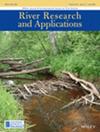Suspended‐sediment response to wildfire and a major post‐fire flood on the Colorado Front Range
IF 1.9
4区 环境科学与生态学
Q4 ENVIRONMENTAL SCIENCES
引用次数: 0
Abstract
Wildfires, and the sediment‐rich floods that commonly follow, increasingly threaten riverine ecosystems and water infrastructure. Suspended sediment exported throughout fire–flood sequences poses particular risks due to rapid transit times and direct impacts on water quality. However, opportunities to measure suspended‐sediment transport during and after post‐fire floods, and therefore to illuminate what controls the magnitude and timing of suspended‐sediment export from burned, flooded watersheds, are rare. A ~ 100‐year flood that occurred one year into a three‐year study monitoring suspended‐sediment response to wildfire in the Colorado Front Range provides a unique opportunity to (1) quantify how suspended‐sediment concentrations and loads change throughout a fire–flood sequence, and (2) infer what controls the timescale over which suspended‐sediment dynamics recover toward pre‐fire conditions. We find that suspended‐sediment concentrations (SSCs) during summer storms declined monotonically to background conditions over 3 years. Snowmelt SSCs peaked in the second year before declining to background levels. Sediment load calculations reveal that the flood exported ~35 years' worth of suspended sediment and triggered ~1.5 years of elevated SSCs and sediment loads. SSCs and sediment loads indicate a fairly short post‐fire recovery timescale of about 3 years. We suggest that the flood accelerated recovery by (1) exporting much of the available suspended sediment from this supply‐limited landscape and (2) facilitating the export of remaining sediment by making it more accessible to subsequent flows. Our results indicate that large post‐wildfire floods, though representing major geomorphic disturbances, may hasten post‐fire suspended‐sediment recovery to background conditions, at least in supply‐limited regions.悬浮沉积物对科罗拉多前沿山脉野火和火后大洪水的反应
野火以及通常随之而来的富含沉积物的洪水日益威胁着河流生态系统和水利基础设施。在整个火灾-洪水过程中输出的悬浮泥沙因其快速的传输时间和对水质的直接影响而构成特别的风险。然而,在火灾后洪水期间和洪水后测量悬浮沉积物迁移的机会非常罕见,因此也很难了解是什么在控制着被烧毁的洪水流域悬浮沉积物输出的规模和时间。在科罗拉多前沿山脉进行的一项为期三年的悬浮沉积物对野火响应的监测研究中,有一年发生了 ~ 100 年一遇的洪水,这为我们提供了一个独特的机会来 (1) 量化悬浮沉积物浓度和负荷在整个火灾-洪水序列中的变化情况,以及 (2) 推断是什么控制了悬浮沉积物动态恢复到火灾前状态的时间尺度。我们发现,夏季风暴期间的悬浮沉积物浓度(SSCs)在 3 年内单调下降至背景条件。融雪时的悬浮沉积物浓度在第二年达到峰值,然后下降到背景水平。沉积物负荷计算显示,洪水输出了约 35 年的悬浮沉积物,并引发了约 1.5 年的 SSCs 和沉积物负荷升高。SSCs 和沉积物负荷表明,火灾后的恢复时间相当短,约为 3 年。我们认为,洪水通过以下方式加速了恢复:(1)从这一供应有限的地貌中输出了大量可用的悬浮沉积物;(2)通过使剩余沉积物更容易被后续水流带走,促进了剩余沉积物的输出。我们的研究结果表明,野火后的大洪水虽然代表着严重的地貌干扰,但至少在供应有限的地区,它可能会加速火后悬浮沉积物恢复到背景条件。
本文章由计算机程序翻译,如有差异,请以英文原文为准。
求助全文
约1分钟内获得全文
求助全文
来源期刊

River Research and Applications
环境科学-环境科学
CiteScore
4.60
自引率
9.10%
发文量
158
审稿时长
6 months
期刊介绍:
River Research and Applications , previously published as Regulated Rivers: Research and Management (1987-2001), is an international journal dedicated to the promotion of basic and applied scientific research on rivers. The journal publishes original scientific and technical papers on biological, ecological, geomorphological, hydrological, engineering and geographical aspects related to rivers in both the developed and developing world. Papers showing how basic studies and new science can be of use in applied problems associated with river management, regulation and restoration are encouraged as is interdisciplinary research concerned directly or indirectly with river management problems.
 求助内容:
求助内容: 应助结果提醒方式:
应助结果提醒方式:


